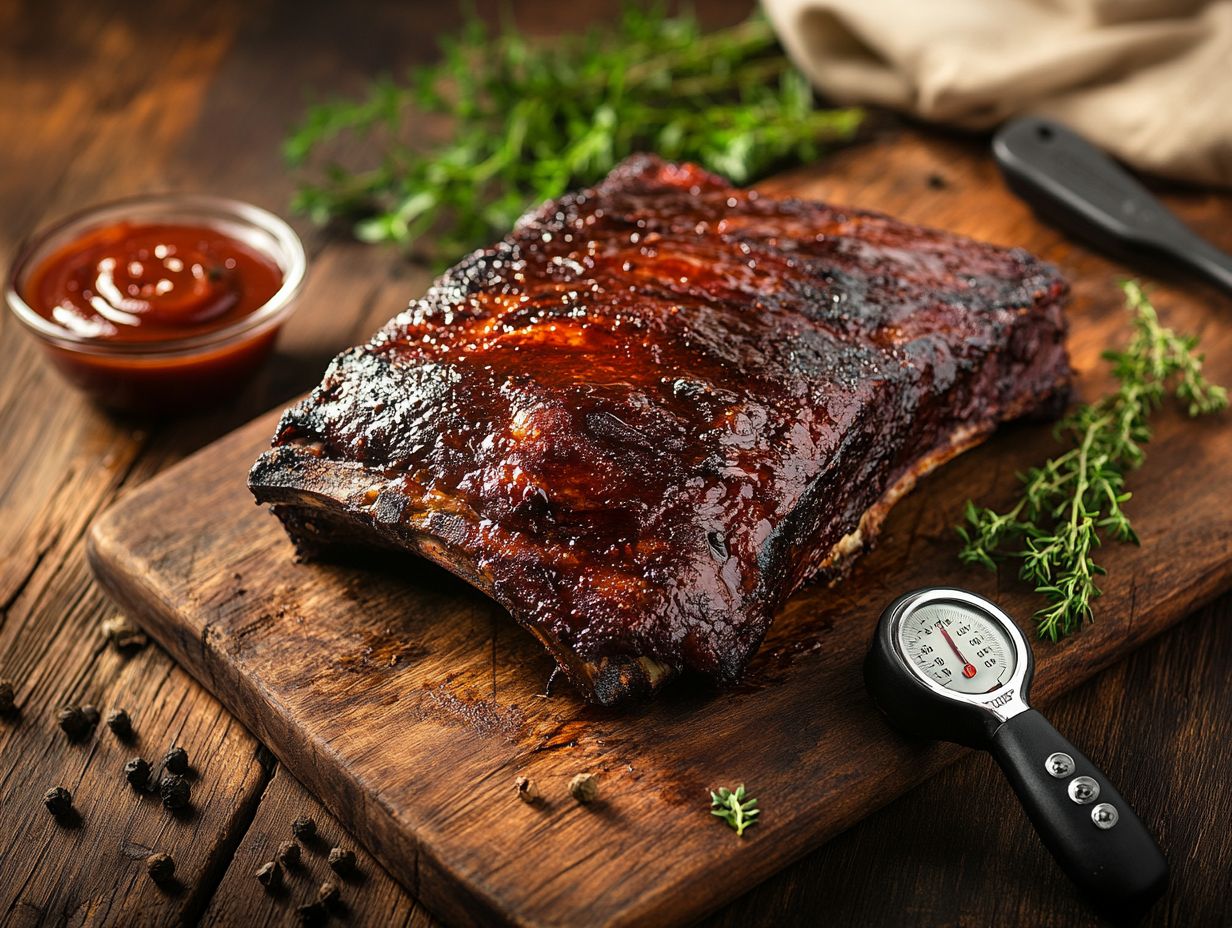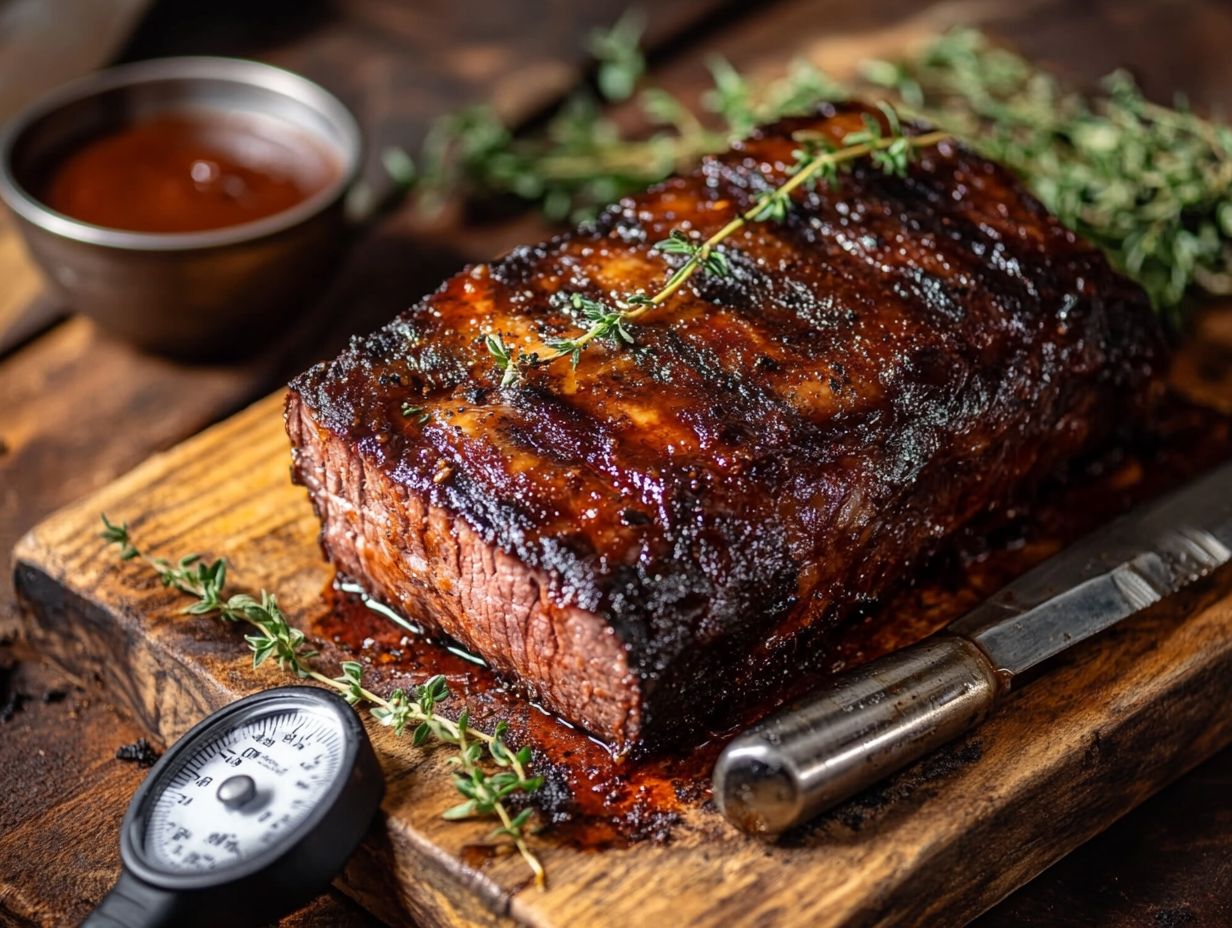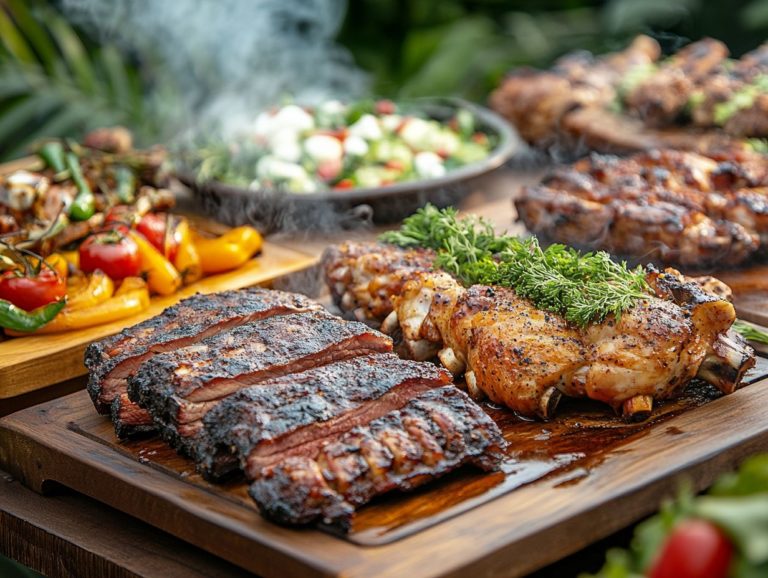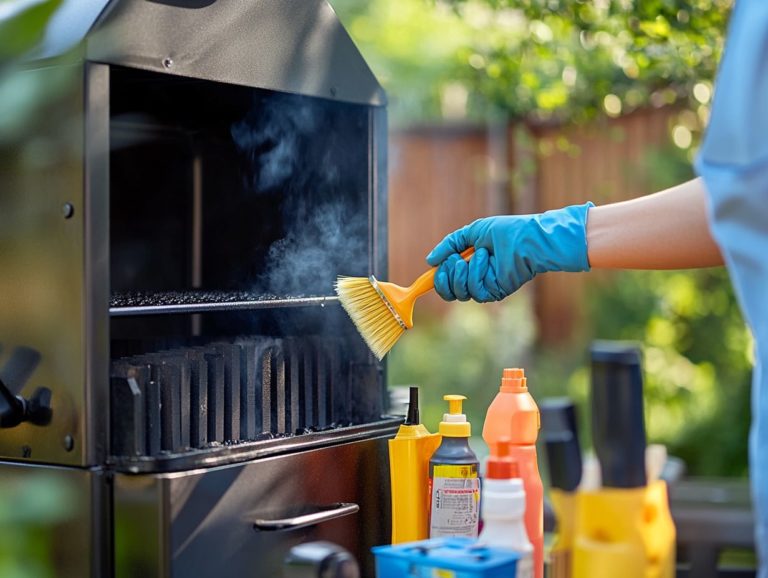How to Avoid Overcooked Smoked Meat
Overcooking smoked meat can transform what should be a culinary masterpiece into a dry, flavorless disappointment. Grasping the causes behind this common pitfall is crucial for any aspiring pitmaster aiming for that perfect smoky tenderness.
Let s dive into how overcooking affects your food! This guide offers visual and tactile cues to help you identify when your meat has crossed the line into overdone territory. You ll also discover practical tips to sidestep this culinary blunder.
This guide also explores alternative cooking methods that can elevate your grilling game to new heights. Immerse yourself in these insights to ensure your next smoked dish is nothing short of spectacular!
Contents
- Key Takeaways:
- What Causes Overcooking?
- Effects of Overcooked Smoked Meat
- How to Tell if Meat is Overcooked
- Tips for Avoiding Overcooked Smoked Meat
- Alternative Cooking Methods
- Frequently Asked Questions
- What is the best way to avoid overcooked smoked meat?
- Why is it important to avoid overcooking smoked meat?
- How can I prevent my smoked meat from becoming overcooked?
- What are some signs that smoked meat is overcooked?
- Can I still salvage overcooked smoked meat using the Bradley Digital Thermometer?
- Are there any tips for avoiding overcooked smoked meat for beginners using the Bradley Digital Thermometer?
Key Takeaways:

- Proper temperature and timing are key in avoiding overcooked smoked meat. Use a thermometer and follow recommended cooking times for perfect results.
- Marinades and brines can help prevent meat from drying out. They add flavor and moisture, resulting in a juicier end product.
- Accidentally overcooked your meat? Don t worry! Alternative cooking methods such as grilling or roasting can help salvage the dish and still provide a delicious meal.
What Causes Overcooking?
Overcooking is a frequent misstep when smoking premium cuts of meat, like brisket. It often stems from inadequate temperature control during the smoking process. When the internal temperature surpasses the desired range, the meat sacrifices its moisture and flavor, resulting in a dry and unappealing outcome.
The type of smoker you choose be it a charcoal or electric model significantly influences your ability to maintain a consistent temperature. Techniques like spritzing (mist with liquid) or using soaked alder chips can help retain moisture. You might also consider using a meat injector for added flavor and moisture, helping to preserve the quality of your smoked masterpiece.
Effects of Overcooked Smoked Meat
When smoked meat is overcooked, you may encounter drastic shifts in both texture and flavor, making it far less appealing and quite tough.
If brisket or other meats are subjected to excessively high temperatures for too long, they inevitably lose moisture, compromising the meat’s overall quality, including its tenderness and juiciness.
This loss of moisture detracts from the mouthfeel and diminishes the rich, smoky flavors that define a truly successful smoking experience.
Texture and Flavor Changes
The texture of overcooked brisket becomes tough and dry. The flavor often suffers, missing that rich smokiness that only comes from a well-executed smoking process. When brisket is exposed to too much heat and time, its fibers tighten, leading to a rubbery mouthfeel, a stark contrast to the succulent tenderness of properly smoked meat.
On the flip side, a perfectly cooked brisket melts in your mouth, offering a juicy, flavorful experience enhanced by the gradual infusion of smoke from wood chips like hickory or mesquite. This tenderness allows the natural flavors to shine, creating a delightful balance of meatiness and smokiness.
The difference becomes even more apparent when you compare slices overcooked brisket resembles dried-out strands, while well-smoked brisket boasts a pink smoke ring and a moist, flavorful interior that tempts every palate.
How to Tell if Meat is Overcooked

Identifying overcooked meat is essential for achieving that perfect smoke flavor and texture you desire. There are several visual and tactile signs to watch for.
When cooking brisket or any other cut, keep a close eye on the internal temperature it’s crucial for juicy results! Ideally, it should fall between 195 F to 205 F for optimal results. Look for visual cues such as excessive dryness or a hardened crust. Also, pay attention to tactile signs like a lack of bounce when pressed, which indicates that the meat may have surpassed the desired level of doneness.
Visual and Tactile Signs
Visual signs that you ve overcooked your brisket are hard to miss. Look for a dry, cracked surface and an unsightly dark color.
Tactile signs will also reveal a distinct lack of tenderness and moisture. These indicators are vital not only for brisket but for a range of cuts, including ribeye and pork shoulder, which can also fall victim to the perils of overcooking.
Take ribeye, for instance it may display a similarly dry appearance, with a hardened crust that masks its rich, marbled texture. When you slice into an overcooked pork shoulder, you might find it excessively firm, with a stringy, tough consistency instead of the juicy tenderness you crave.
By recognizing these characteristics, you set yourself on the path to achieving the perfect level of doneness. This ensures that every cut retains its flavorful essence and delightful mouthfeel.
Tips for Avoiding Overcooked Smoked Meat
To achieve succulent, perfectly cooked meat, you must follow some key strategies during the smoking process. Start by maintaining consistent temperature control and selecting high-quality cuts, such as brisket.
Using a Bradley Digital Thermometer allows you to monitor internal temperatures precisely. This way, your meat remains tender and juicy and reaches the ideal temperature. Consider incorporating a meat injector or liquid brine to enhance moisture retention.
Use indirect heat cooking, and regularly spritz your meat with apple juice to strike the ideal balance of moisture and flavor throughout the cooking process, especially with quality cuts of meat.
Proper Temperature and Timing
Proper temperature control and timing are vital for success in smoking meat, particularly with brisket in a charcoal smoker.
To achieve that perfect brisket, you need the right spices and a solid grasp of how smoking temperatures and timing work together to elevate the meat s flavor and texture. When your smoker maintains consistent temperatures, the collagen in the brisket gradually breaks down, leading to tender, juicy slices that practically fall apart at your touch.
Each cut of meat has its own specific needs. While brisket thrives on a low-and-slow approach, other cuts like ribs may prefer a higher heat for optimal results.
By understanding the intricacies of each cut like beef, pork, veal, lamb, chicken, and turkey you can create a more satisfying culinary experience. This ensures that every bite reflects your dedication to meticulous preparation and attention to detail.
Marinades and Brines

Utilizing marinades and liquid brines is an exceptional technique for enhancing moisture retention in smoked meat, especially brisket, which tends to dry out during cooking.
These methods not only infuse your meat with flavor but also form a protective barrier, keeping it juicy throughout the lengthy smoking hours. A straightforward brine could consist of water, salt, and a hint of sugar to balance flavors, while more sophisticated marinades might include ingredients like soy sauce, apple cider vinegar, and aromatic spices.
Consider techniques like injecting a marinade directly into the meat or allowing it to soak overnight to enhance both texture and taste. When preparing beef ribs or pork shoulders, the right blend of acidity and herbs in your brine can ensure that every bite is succulent and rich, making your smoking experience even more rewarding.
Alternative Cooking Methods
While smoking may be the go-to technique for crafting exquisite cuts like smoked brisket, don t overlook alternative cooking methods such as grilling and roasting. These methods can also yield delightful results, especially when you’re pressed for time and want to try different BBQ Champs Academy techniques.
Each method brings a distinct flavor and texture to the table. Grilling provides a faster cooking experience, while roasting results in tender, evenly cooked meat making it a great option for ribs or brisket. By mastering these techniques, you can broaden your cooking skills while still maintaining the vital elements of taste and quality.
Grilling and Roasting Techniques
Grilling and roasting techniques offer distinct avenues to prepare quality cuts of meat. Each method presents unique flavor profiles and textures that can rival the outcomes of smoking.
Grilling typically operates at higher temperatures, ranging from 400 to 600 degrees Fahrenheit. In contrast, roasting relies on the gentle embrace of lower temperatures, around 325 to 450 degrees. For instance, grilling a steak often takes just a few minutes per side, achieving that perfect sear while allowing the meat’s natural juices to beautifully caramelize. Roasting a prime rib, however, demands several hours of patience, enhancing tenderness and depth of flavor.
When you compare these methods to smoking, which operates at cooler temperatures for extended periods, the differences become strikingly clear. Smoking adds rich, smoky undertones to the meat but lacks the immediate char and crispy texture that grilling and roasting deliver. This highlights the diverse culinary options available for any meat enthusiast.
Frequently Asked Questions
What is the best way to avoid overcooked smoked meat?

The best way to avoid overcooked smoked meat is to monitor both the temperature of your smoker and the internal temperature of the meat. Using a meat thermometer will help ensure the meat cooks perfectly.
Why is it important to avoid overcooking smoked meat?
Overcooked smoked meat ends up tough and dry, ruining that mouthwatering flavor you crave! Achieving the desired tenderness and juiciness is essential for an enjoyable dish.
How can I prevent my smoked meat from becoming overcooked?
To prevent overcooking, use a low and slow cooking method. This allows the smoke to add flavor without drying out the meat. Wrapping the meat in foil during the last stage of cooking can also help retain moisture.
What are some signs that smoked meat is overcooked?
Signs of overcooked smoked meat include a dry and tough texture, a lack of juices when sliced, and a dark, charred exterior. Monitoring the appearance and texture while cooking can help avoid this issue.
Can I still salvage overcooked smoked meat using the Bradley Digital Thermometer?
In some cases, you can salvage overcooked smoked meat by adding moisture back into the dish. This can be done with a sauce or marinade, or by slicing the meat thinly and incorporating it into a moist dish like a soup or stew.
Are there any tips for avoiding overcooked smoked meat for beginners using the Bradley Digital Thermometer?
For beginners, start with a small amount of meat to practice using a smoker and get familiar with the cooking process. Using a digital meat thermometer will help you achieve the desired temperature. Remember, patience is key; slow and steady cooking will yield the best results.






